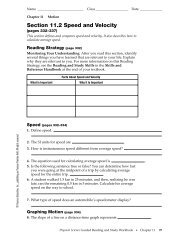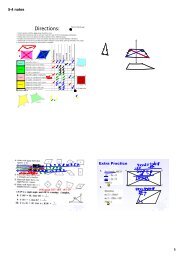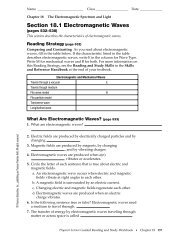Study Guide 1.3 - Barrington High School
Study Guide 1.3 - Barrington High School
Study Guide 1.3 - Barrington High School
Create successful ePaper yourself
Turn your PDF publications into a flip-book with our unique Google optimized e-Paper software.
Name ___________________________ Class ___________________ Date _____________<br />
Chapter 1<br />
Science Skills<br />
Section <strong>1.3</strong> Measurement<br />
(pages 14–20)<br />
This section discusses units of measurement, making and evaluating<br />
measurements, and calculations with measurements.<br />
Reading Strategy (page 14)<br />
Previewing Before you read the section, rewrite the green and blue<br />
topic headings in this section as questions in the table below. As you<br />
read, write answers to the questions. For more information on this<br />
Reading Strategy, see the Reading and <strong>Study</strong> Skills in the Skills and<br />
Reference Handbook at the end of your textbook.<br />
Why is scientific notation useful?<br />
Measurement<br />
© Pearson Education, Inc., publishing as Pearson Prentice Hall. All rights reserved.<br />
Using Scientific Notation (pages 14–15)<br />
1. Scientific notation expresses a value as the product of a number<br />
between 1 and 10 and .<br />
2. Circle the letter of the value that is expressed as 3 10 8 .<br />
a. 300 b. 300,000<br />
c. 30,000,000 d. 300,000,000<br />
3. Why is scientific notation useful?<br />
SI Units of Measurement (pages 16–18)<br />
4. Circle the letters of elements that are required for a measurement to<br />
make sense.<br />
a. scientific notation b. numbers<br />
c. exponents d. units<br />
5. Is the following sentence true or false? Units in the SI system<br />
include feet, pounds, and degrees Fahrenheit.<br />
Match the SI base unit with the quantity that is used to measure.<br />
SI Base Unit<br />
Quantity<br />
6. meter<br />
a. Mass<br />
7. kilogram<br />
b. Time<br />
8. kelvin<br />
c. Length<br />
9. second<br />
d. Temperature<br />
Physical Science <strong>Guide</strong>d Reading and <strong>Study</strong> Workbook ■ Chapter 1 5
Name ___________________________ Class ___________________ Date _____________<br />
Chapter 1<br />
Science Skills<br />
SI Prefixes<br />
Prefix Symbol Meaning Multiply Unit By<br />
giga- G 1,000,000,000<br />
mega- M million (10 6 )<br />
kilo- k thousand (10 3 ) 1000<br />
deci- d 0.1<br />
centi- hundredth (10 2 ) 0.01<br />
m thousandth (10 3 ) 0.001<br />
µ millionth (10 6 ) 0.000001<br />
nano- billionth (10 9 ) 0.000000001<br />
10. Complete the table of SI prefixes by filling in the missing<br />
information.<br />
11. A ratio of equivalent measurements that is used to convert a<br />
quantity expressed in one unit to another unit is called a(n)<br />
.<br />
Limits of Measurement (page 19)<br />
12. Circle the letter of each expression that has four significant figures.<br />
a. 1.25 10 4 b. 12.51<br />
c. 0.0125 d. 0.1255<br />
13. Is the following sentence true or false? The precision of a<br />
calculated answer is limited by the least precise measurement<br />
used in the calculation.<br />
true<br />
14. Calculate the density if the mass of a solid material is measured as<br />
15.00 grams and its volume is measured as 5.0 cm 3 ? Round off<br />
your answer to the proper number of significant figures.<br />
15. Describe the difference between precision and accuracy.<br />
Measuring Temperature (page 20)<br />
16. Circle the letter of the base unit of temperature in SI.<br />
a. degree Fahrenheit (°F) b. degree Celsius (°C)<br />
c. candela (cd) d. kelvin (K)<br />
17. Write the formula used to convert degrees Celsius to kelvins.<br />
© Pearson Education, Inc., publishing as Pearson Prentice Hall. All rights reserved.<br />
6 Physical Science <strong>Guide</strong>d Reading and <strong>Study</strong> Workbook ■ Chapter 1




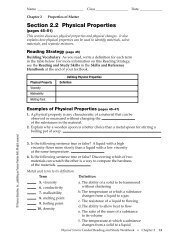
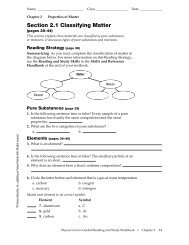
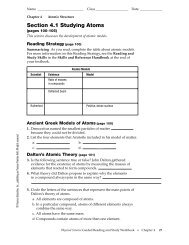
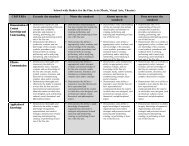
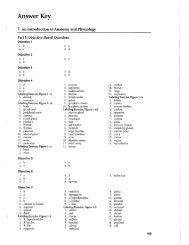
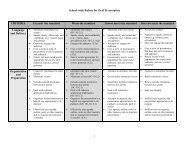
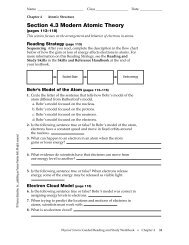
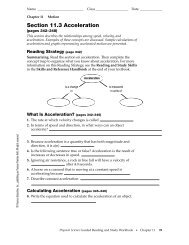
![Nov1-3 [Laurie Garland] - The Charles A. Dana Center](https://img.yumpu.com/26208999/1/190x146/nov1-3-laurie-garland-the-charles-a-dana-center.jpg?quality=85)

